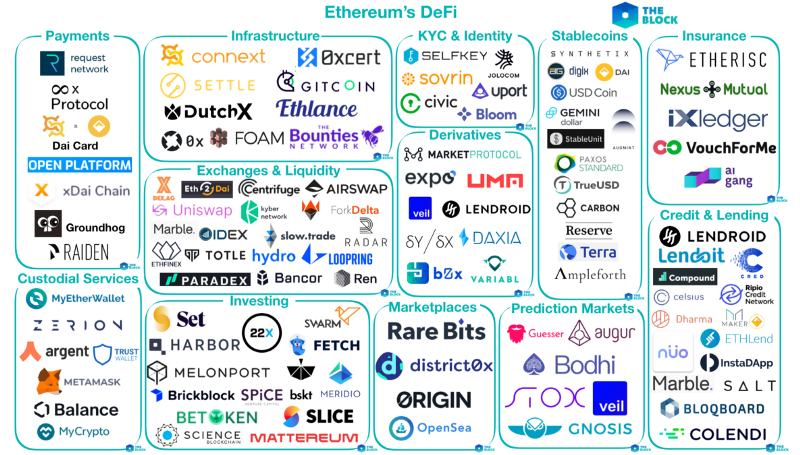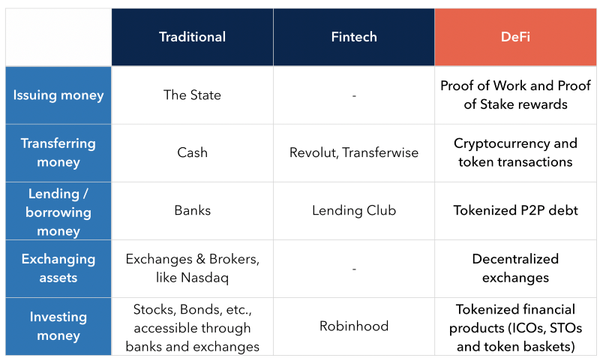Decentralized finance is here, and it has the potential to become the driving force of a more open economy
Decentralized finance — or DeFi for short — is an umbrella term for services like investing, borrowing, lending and trading based on decentralized, non-custodial infrastructure. Blockchain and cryptocurrencies initiated the conversation on how we can democratize the global economy, but it’s DeFi that is going to get us there.
The problem with centralized finance
Financial markets can drive the prosperity of society by enabling great ideas to become reality, but power in finance is centralized: most people are locked out of decisions about what gets funded and get only a small portion of the profits from the projects that do.
More than half of global VC funding goes to U.S. startups, most of which are in a few cities like SF and New York City. Meanwhile, even in the U.S., the bottom 80 percent of society own only 7 percent of company shares, and individuals in many other nations do not even have access to stock markets. Finance is central to the global economy, but it is not an open system.
When most people invest, they pass over control of their assets to banks and other intermediaries so professional managers can work wisely with the money in the financial market. The logic is that they will make higher returns and therefore account holders also benefit.
However, the result is keeping control and risk at the center of the system. We know that bankers, as experienced as they may be, are still fallible and can fail to see risks in the markets, as in the 2008 housing bubble. When they control all the money, risk accumulates at the center and endangers the entire system.
In addition, the way most people save with banks doesn’t leave them in control of their own money. Account balances are just numbers. In reality, banks use that money in ways that most people don’t understand. In times of emergency, bank runs can quickly lead to zero cash balances, as seen in places like Argentina, Venezuela and Zimbabwe. When money isn’t actually yours, it becomes harder to move. Fiat money is restricted locally. It might be easy to transfer money between the US and Europe, but that’s about it — try sending remittances abroad and you are met with walls of red tape and fees for middlemen.
Incomplete decentralization
Satoshi created Bitcoin in 2008 as the first-ever solution to have global peer-to-peer settlements with no intermediaries required, so that individuals could keep control over their assets. However, Bitcoin and early cryptocurrencies only decentralized the issuance and storage of money, not access to a broader set of financial instruments.
Two major issues with the current crypto space stand out:
- Firstly, although protocols are decentralized and based on consensus algorithms, many access points to the system, like exchanges, are still centralized.
- In addition, many crypto projects are managed through centralized organizations or companies that too often lack transparency or accountability, and do not openly show the development of new parts of the ecosystem.
The “blockchain revolution” promised to open up finance, but we quickly saw that it only did this for a few people.
The question of access
It is not surprising that fields like finance and cryptocurrencies, where participants must have high degrees of knowledge and access to enter, are not very open to large parts of the world.
Nevertheless, because of the key role that finance plays today and that blockchain-based finance will likely play in the future, it is problematic that the majority of humanity should be locked out. Diversity helps decision-making, and we could avoid a lot of fights over taxation if our financial system was more fair and open from the outset.
The solution is to build tools that enable us to take control of our assets and our decisions about them.
Decentralized finance
Many fintech firms and new-age banks promise to give more control to the consumer. These are misleading promises because in most cases, banks still manage the assets, and the customer has to trust the bank to take good care of it. They are faster and more convenient, but not fundamentally different from old banking.
True disruption only comes with full individual control over assets and access, and technology is now enabling this reality. Many builders for innovative financial products are moving towards open-source protocols for exchanging assets through decentralized platforms. The new platforms have two huge advantages over finance as it exists today.
- Firstly, individuals will be able to unlock many known and new forms of value while not having to trust any intermediary to take care of their assets for a commission. Anyone has access and there is no central control.
- Secondly, all protocols are open-source, so anyone can build new financial products on top of them and people from across the globe can collaborate and come up with new forms of creating value. This can lead to ever-faster innovation and strong network effects as more and more users and builders move onto the platforms.
Decentralized finance, or DeFi, already provides a range of common financial vehicles and marketplaces that ensure that the individual is the sole custodian of their assets at all times. DeFi protocols are characterized by three things: they’re interoperable, programmable and composable.
Interoperable means that functionality isn’t siloed. The current financial system is controlled by middlemen and rent seekers, so it’s the norm to restrict access based on arbitrary factors like nationality, income or the bank you use. DeFi is defined by transparency and functions that work seamlessly together, regardless of who created them.
Programmable means that transactions are controlled by smart contracts, not people. This makes the system more secure and customizable, so there are limitless possibilities.
Composable means that the entire system is a bit like a box of Lego blocks — there is no limit to what can be built. Everything can be assembled in multiple combinations and there’s always a perfect fit.

Today, all these protocols are based on Ethereum smart contracts. Some of the most promising and advanced ones are:
- Decentralized exchanges like Uniswap, 0x and Kyber
- Non-asset-backed stablecoins like Dai and USDC, with a reliable value for hedging and cross-border transfers
- Automated asset management strategies such as Set Protocol, which offers a decentralized equivalent to ETFs
- Money markets such as Compound and Aave
- Margin trading, like DyDx
- Tokenized debt platforms like Dharma or Compound for lending and borrowing
- Insurance such as Opyn and Nexus
The markets for them are small for now, but they promise, for the first time, a global financial marketplace with programmable stores of value that do not just serve but belong to the individual. You can find a full list of projects in this great list.
To put these ideas into perspective, here’s how DeFi is upgrading all the functions of finance:
Before we get started on how to enter the market, we will take you on a tour through the protocols that underlie decentralized finance. In the next weeks, we will post introductions into all the protocols I’ve mentioned here, and why they are better than the status quo.
This is finance for the informed, critical, and enthusiastic who do not accept centralized control and unequal access. Join us!
Read Part 2 on stablecoins here.
📢 Try Zerion Wallet, follow us on Twitter to get latest updates, or join our Discord server.


